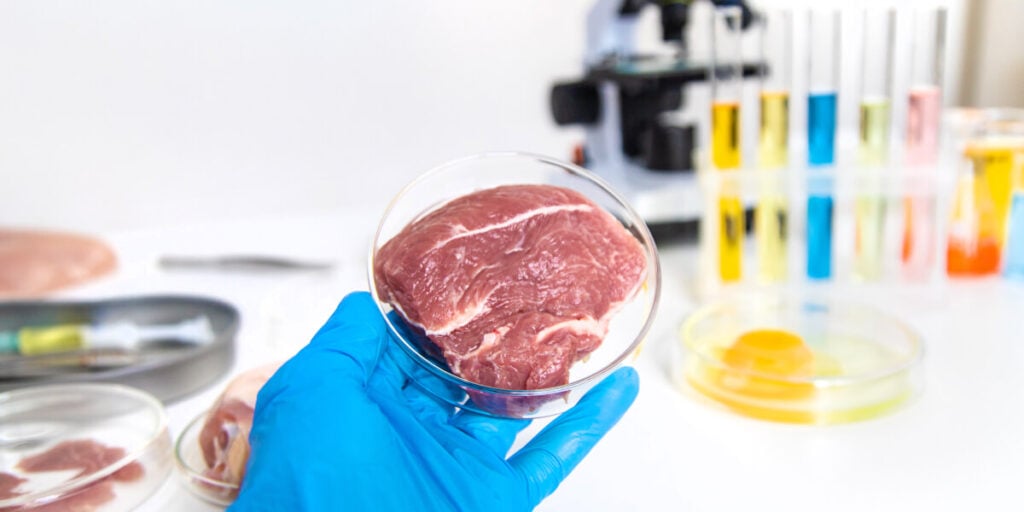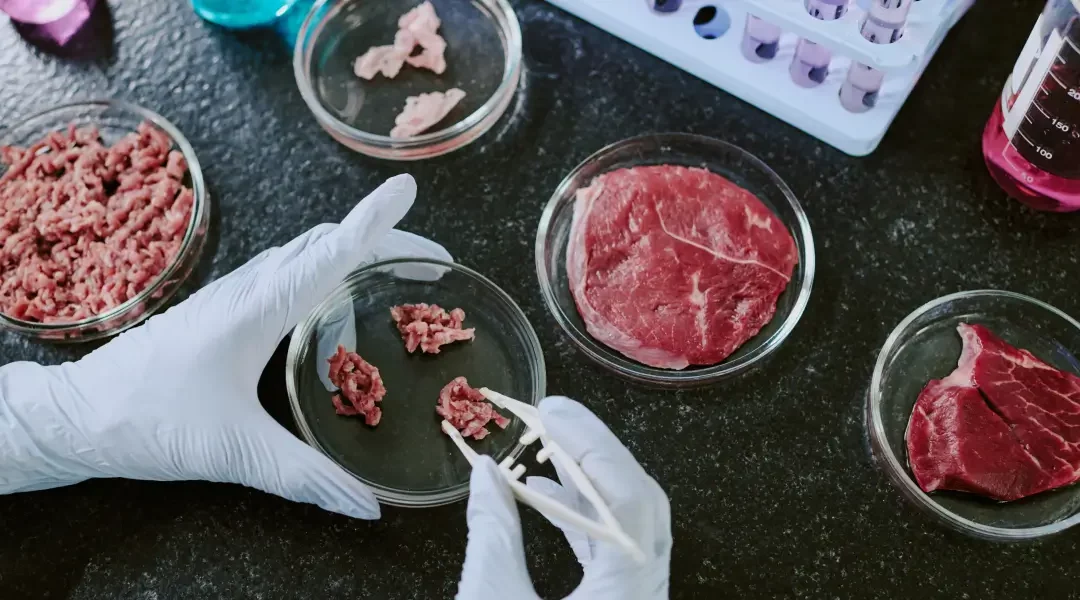Lab-grown meat (also known as cultivated meat or cultured meat) is genuine animal meat produced by growing animal cells outside of a living animal in a controlled environment.In essence, instead of raising and slaughtering livestock, we can cultivate muscle and fat cells in a bioreactor to obtain meat products.
The end result is biologically equivalent to conventional meat in taste and nutritional profile, but:
a) it can be created with fewer resources
b) it potentially has less environmental impact
History behind lab-grown meat
This concept moved from science fiction to reality in 2013, when Dutch scientist Mark Post unveiled the world’s first cell-cultured burger on live television. Since then, the field has grown rapidly and as of 2024 there were over 175 startups and companies worldwide focused on cultured meat, backed by more than $3.1 billion in investments.
How Is Lab-Grown Meat Produced?
Producing lab-grown meat is a multi-step process grounded in cell biology and tissue engineering. The goal is to take a small sample of animal cells and grow them into a sizeable portion of edible muscle (and fat) tissue. The process can be broken down into four key
Stage 1. Cell Sourcing and Cell Line Development:
Scientists begin with a small sample of animal cells, often taken via a biopsy from muscle tissue or a fertilized egg, in a way that typically does not kill or seriously harm the animal. The cell types used are often stem cells or precursor cells capable of proliferating. These cells are screened and selected for their ability to grow well, and a “master cell bank” is created to store a stable supply of starter cells for future cultivation.
Stage 2. Cell Cultivation in Bioreactors
The cells are immersed in a nutrient-rich culture medium containing water, sugars, amino acids, vitamins, minerals, and other essential nutrients, much like a cell “feed.” Often, the medium is supplemented with specific growth factors and proteins that signal the cells to multiply. Within days, the few starter cells can proliferate into billions of cells, all suspended in the bioreactor.
Stage 3. Differentiation and Tissue Formation
Once a sufficient mass of cells is grown, the next step is to prompt these cells to differentiate, that is, to mature from generic precursor cells into the specific types of cells we find in meat (muscle fibers, fat cells, and connective tissue cells).
Stage 4. Harvesting and Food Processing
The harvested cell biomass is then processed using conventional food processing techniques to form the final meat product. Finally, the product is packaged and kept under refrigeration or other preservation method similar to regular meatfsis.usda.gov. The entire cultivation process from the initial cell inoculation to a ready-to-cook meat product typically takes about 2 to 8 weeks.
Food Safety and Quality Assurance Considerations
Food Safety and Quality Assurance (FSQA) professionals will need to adapt established frameworks, such as HACCP (Hazard Analysis and Critical Control Points) and ISO 22000 (a food safety management system standard) to the cultivated meat production process. In many ways, the safety considerations for cultivated meat are familiar. Experts note that most potential hazards “are already well known and exist equally… in conventionally produced food” according to GFI Europe.
Here’s a quick FSQA guide for lab-grown meat:
| Category | Summary |
| Hazard Analysis & Critical Control Points (HACCP) | Cultivated meat facilities require customized HACCP plans focused on sterility, with lower risk of gut pathogens and no need for antibiotics. |
| Regulatory Oversight and Standards | Regulatory bodies like USDA FSIS now inspect cultivated meat facilities, and ISO 22000 standards apply even though no specific cell-based standard exists yet. |
| Quality Assurance and Nutritional Aspects | Cultivated meat must match conventional meat in taste, nutrition, and shelf-life, with early approvals already confirming comparable quality. |

Halal & Kosher Certification and Religious Dietary Compliance
One important consideration as lab-grown meat enters the market is how it fits into religious dietary laws, such as halal for Muslims and kosher for Jews. Because cultivated meat blurs the traditional lines of animal slaughter, it has prompted extensive discussions among religious scholars and certification bodies about its permissibility. Here we outline the current perspectives and requirements for halal compliance (with parallels to kosher):
a) Halal Considerations
In Islam, for meat to be halal (permissible), it generally must come from an animal that is halal to eat (e.g. not pork, not carnivorous, etc.) and that has been slaughtered according to Islamic law (including invocation of God’s name and a cut that causes the animal’s blood to drain).
Lab-grown meat raises the question: if no animal is slaughtered, can the meat be considered halal by default, or must the origin of the cells meet halal criteria? In 2023, GOOD Meat (Eat Just’s cultivated meat division) convened a panel of Shariah experts to examine this question. The scholars concluded that cultivated meat can be halal if certain conditions are met, chiefly that the initial cell source must come from an animal that was slaughtered in a halal manner.
In practice, this means that if a company wants halal certification, it should obtain the starter cells (say a chicken muscle biopsy or a cow cell line) from an animal that was slaughtered by zabiha (Islamic ritual slaughter). Alternatively, if the cells are taken from a living animal without slaughter, one could interpret that the animal should be treated humanely and not harmed.
b) Kosher Considerations
The Jewish dietary law issues are somewhat parallel, with some differences in interpretation. Kosher rules require that meat come from a kosher species (e.g. cow, sheep, chicken are kosher; pig is not) and that the animal be slaughtered according to shechita (Jewish ritual slaughter), among other rules (such as no mixing of dairy and meat, etc.).
In the case of cultured meat, a key question has been whether the product is considered meat (basar) or something else (which could affect rules like mixing with dairy). In late 2023, the Orthodox Union (OU) ruled that the product was kosher, with reasoning that underscores certain conditions: the chicken cells were originally taken from a fertilized egg (not a slaughtered animal) before any blood formed in the embryo, and the growth process did not use any non-kosher ingredients.
Overall, both halal and kosher authorities are actively developing formal guidelines as the industry moves closer to retail reality. The convergence of expert opinion so far suggests that lab-grown meat can be compatible with religious dietary laws, but producers must be mindful of sourcing and processing details.
Conclusion and Key Takeaways
In summary, lab-grown meat (cultivated meat) represents a cutting-edge intersection of food science, biotechnology, and sustainability. Below are the key points from this guide:
- Lab-grown meat is real animal meat produced in vitro by cultivating animal cells in a controlled environment (bioreactors) rather than by raising and slaughtering animals.
- Cultivated meat production takes only weeks to develop, not months or years, and leverages advances in cell biology and tissue engineering. Current techniques excel at producing minced or ground meat products, while work continues to perfect whole-cut textures (using innovations like edible scaffolds and perfusion bioreactors).
- Overall, with proper controls, lab-grown meat can be as safe as conventional meat, and frameworks like ISO 22000 are being applied to maintain quality and safety management.
- Religious dietary laws are adapting to this novel food. Islamic authorities have started to declare that cultivated meat can be halal if the cell source is from a halal-slaughtered animal and all ingredients are halal-compliant. Similarly, kosher certifiers have deemed certain cultured meats kosher when derived from kosher species with appropriate handling.
Sources:
- Good Food Institute – The science of cultivated meat: Definition, process, and industry stats.
- USDA FSIS – Human Food Made with Cultured Animal Cells: Overview of production steps and regulatory.
- Reuters – Lab-grown meat can be kosher and halal, experts say (Sept 2023): Panels of experts outline religious conditions for cultured meat.
- Georgia Farm Bureau News – USDA approves sale of lab-grown meat (Jul 2023): U.S. regulatory approval for Upside Foods and GOOD Meat cultivated chicken.
- GFI Europe – Food safety in cultivated meat: FAO report takeaways (Apr 2023): Experts find most hazards similar to conventional meat.
- Reuters – Italy’s parliament approves ban on lab-grown food (Nov 2023): Example of regulatory pushback banning cell-cultured foods.
- American Halal Foundation – Are Cell-Cultured (Lab-Grown) Meats Halal? An Authoritative Guide – Mohammad Hussaini
Azmi is a dynamic content and client development professional at the American Halal Foundation, blending his passion for the halal lifestyle, history, and travel with sharp market insights. Known for his attention to detail and strategic approach, he crafts impactful content that drives engagement and strengthens AHF’s connection with global audiences.




